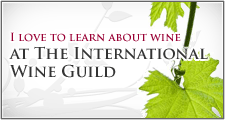Buttery– Buttery aromas and flavors exist in wines that have undergone malolactic fermentation, a process that sometimes follows a wine’s alcoholic fermentation. In the malolactic process, bacteria convert malic acid (which is fairly harsh) to lactic acid (which is softer on the palate), and a byproduct of the reaction is a compound called diacetyl. Diacetyl is the same compound found in butter which makes butter smell, well, buttery. Most red wines undergo malolactic fermentation, but diacetyl is faint enough that by the time a red wine is bottled and released, the buttery aromas are pretty well masked by all the wine’s other aromas. White wines don’t have quite as much going on with their aromatics, so that buttery quality is more apparent to the nose. Not all whites undergo malolactic fermentation, and in many cases the buttery quality would clash with the other flavors and aromas and be generally unpleasant. The exception to this is Chardonnay, which often benefits from the flavor. And since the butteriness is the result of the conversion of harsh malic acid to soft lactic acid, buttery wines are generally wines with lower perceived acidity.
Oxidized– Just as oxidization wipes out a wine’s bright colors over time, it wipes out the bright flavors and aromas. The result, for example, would be that a wine with flavors of fresh strawberries turns into a wine with very faint flavors of strawberries and dominant flavors of alcohol, old caramel, sherry, and occasionally acetic acid. Except for the alcohol, these types of flavors are the result of oxidation, and once a wine’s fruit is gone, that’s all you’re left with. A little oxidation is usually good, especially considering that without oxidation, great wine would never mature to become even greater wines. The damage to a wine is when the process goes too far. I should point out that there’s nothing harmful about a wine in this state; the worst it will do is offend your nose and palate.
Reduced– Chemically speaking, this is the complement of oxidized, and neither reaction takes place without the other. But just because excessive oxidation is a fault, this doesn’t mean that a reduced wine is preferable to one that is oxidized. If there is too little oxygen available to a wine, the result is that the wine can show skunky aromas of sulfur, burnt match heads, and something akin to swamp gas. The ideal state for a wine is for there to be a proper equilibrium of reduction and oxidation.
Vinegar– I feel the need to mention this one because it’s a misunderstood term (where wine is concerned, at least) and one that is typically used only by people who don’t understand exactly what vinegar is and what its relationship is to wine. Old, over-the-hill wine is not vinegar; it’s simply old, over-the-hill wine. Vinegar, on the other hand, is the result of taking any dilute alcohol solution (not just wine) and allowing the alcohol to be oxidized and converted into acetic acid by acetobacter bacteria. It is very, very rare for this process to happen spontaneously to a bottle of wine. Yes, over time some of the alcohol in a wine will be converted to acetic acid through the slow process of oxidization, but that does not mean that the wine is vinegar. Even amongst the world’s worst wineries, sanitation is generally good enough that there will be no acetobacter present in the bottled wine, and, therefore, no chance that the wine will ever turn into actual vinegar.
Corked– This is the smell that results from the compound TCA, trichloranisole, which can find its way into wine via a tainted cork. A corked wine has the nasty smell of old, wet, moldy cardboard. The TCA results (ironically) from sanitizing cork with chlorine bleach during the manufacturing process, and once it has affected the wine, there’s nothing that can make it go away. Corked wines are a major problem in the business and are the main reason that many producers have moved to screwcaps and synthetic closures. TCA, I should point out, cannot hurt you; as with an over-the-hill wine, a corked wine will merely offend the nose and palate.
And so there you have it– our brief (ha!) summary of the major descriptors that are used by wine geeks when describing a wine’s appearance and flavor. As mentioned in the introduction to this piece, this is hardly a comprehensive discussion, but it is, I hope, a good start. In the following articles, we’ll take a shot at the various terms we use to describe structure and texture, which will bring us into realms that are rather more subjective and creative.
See you then!






